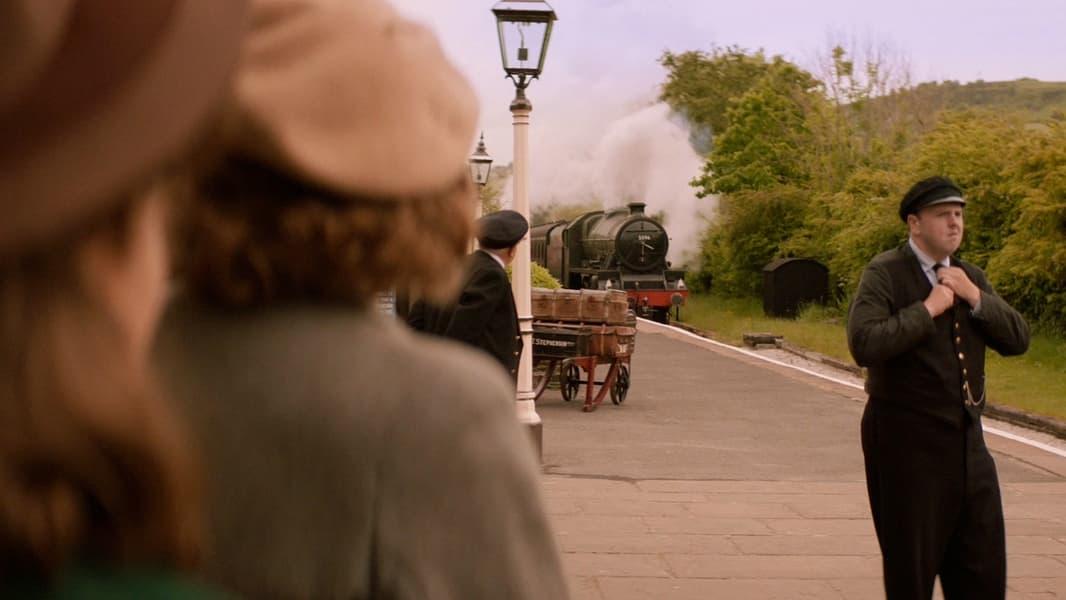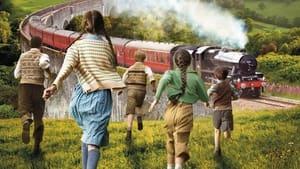The Railway Children Return filming locations take us back to Haworth High Street, Oakworth Station, Oxenhope, the Brontë Parsonage Museum and the stunning Yorkshire scenery that surrounds them. Here’s the real Oakworth village, Three Chimneys, steam railway and more!
Lily (Beau Gadsden), Pattie (Eden Hamilton) and Ted Watts (Zac Cudby) are evacuated from the city to the safety of rural Yorkshire. There they meet Bobbie (Jenny Agutter), who now lives in Oakworth with her daughter Annie (Sheridan Smith) and grandson Thomas (Austin Haynes).
Where Was The Railway Children Return Filmed?
 The Railway Children Return
The Railway Children Return
The Railway Children Return was filmed in Yorkshire at Oakworth Station, the Bronte Parsonage Museum and around Haworth village.
Just like the original, the new Railway Children movie is set and filmed in Oakworth. But the Haworth village locations are not far from Oakworth either – they’re only a mile apart. Not only that, but you can catch a steam train on the The Railway Children’s line between Oakworth and Haworth Stations!
Is The Railway Children Return Based on a Book?
The Railway Children Return is not based directly on a novel, but it picks up directly from the 1970 film. The Railway Children is based on the 1905 book by E. Nesbit, who also wrote Five Children and It. The 1970 movie was based on the original story, which was written in 1905.
In the original book, the Waterburys move from London to Oakworth in Yorkshire after the children’s father is mistakenly arrested. Despite a few rocky moments, they make friends and help those in trouble, even when it means risking their own safety.
In the new Railway Children movie, we find the eldest of the girls, Bobbie still living in Oakworth. We catch up a grown-up Bobbie and her daughter in the 1940s, when a group of evacuees are sent to the village from Manchester.
Like the original trio, the evacuees come to the rescue of those in need – this time, a young American, Abe McCarthy (KJ Aikens). Richard Perks (John Bradley) is on the scene, taking the baton from Perks senior (Bernard Cribbins).
The Oakworth Doctor’s House
 Brontë Parsonage Museum. DeFacto, CC BY-SA 4.0
Brontë Parsonage Museum. DeFacto, CC BY-SA 4.0
The doctor’s house location in The Railway Children movies is the Brontë Parsonage Museum in Haworth, Yorkshire. As you may have guessed, this house already boasts a pretty decent literary connection of its own. The house is really the historic home of the Brontë siblings.
You can find this elegant Railway Children house on Church Street, which ties in with its historic role as home to the Reverend. Charlotte, Anne, Emily and Branwell Brontë’s father was indeed the local cleric.
Brontë Parsonage Museum is only used for exterior shots in the 2022 movie, but tourists can venture further in person. Alongside a museum of the authors’ manuscripts and more, you can walk around the rooms. They’re preserved as they would have been in the 19th Century, complete with furnishings and even a few treasured personal possessions.
The house from The Railway Children Returns opens to the public on set days throughout the week. At the time of writing, you can book in advance to reserve your place before travelling.
The Railway Line
The steam railway location in The Railway Children Return is the Keighley and Worth Valley Railway, a heritage line running through Yorkshire. The towns of Haworth and Oakworth are both in the Keighley area, and their stations are both on the steam railway line.
It’s open to visitors, so you can ride the railway from the Railway Children movies! Check the Keighley and Worth Valley Railway site for details on the dates it’s running and which services you can choose from.
And once you’re a passenger, you can look out for some very familiar locations along the route…
Oakworth Station
 Oakworth Station. RuthAS, CC BY 4.0
Oakworth Station. RuthAS, CC BY 4.0
The real Oakworth Station appears in The Railway Children Return. After its closure as a regular working railway station in the mid-1960s, it was preserved by volunteers. Now it’s part of the Keighley and Worth Valley Railway – and yes, this is the station used in The Railway Children.
Since it’s preserved in the style of the era, visitors can see some of the features that appear in both Jenny Agutter films.
The Three Chimneys
The Railway Children’s Three Chimneys house location is Bents Farm on Bents Lane, in Oxenhope. As you might have guessed from its screen time, it’s set a little way back from the village centre on private land.
Bobbie Waterbury’s home may be off the route, but the village itself isn’t hard to reach. Oxenhope Station is actually the next station down the line from Haworth, and it’s here that the Keighley and Worth Valley Railway terminates.
Oakworth Village High Street
 Haworth Main Street. ianpudsey, CC BY 3.0
Haworth Main Street. ianpudsey, CC BY 3.0
The real village high street in The Railway Children Return is Haworth Main Street. Look out for it in scenes where the children walk and cycle through the village.
Local shops were renamed for the production, to let the Haworth shops magically relocate five minutes up the road. The Telegraph and Argus caught The Souk transforming into Oakworth Village Butchers for the shoot. You can catch sight of other shops beside St Michael & All Angels Church in their new Oakworth signage too.
Fans of the original film might just recognise the street. Haworth’s local high street is a filming location in The Railway Children as well as The Railway Children Returns, adding another connection to the 1970 classic.
If you visit, look out for the Wave of Nostalgia shop, which appeared in the first movie among other locations in the area. You can find it opposite the church, across the road from The Souk.
The Air Force Base
The Railway Children Returns’ Air Force Base location is the Saltaire Mill Museum, a popular filming location that’s appeared in many period dramas. One of its recent appearances was in The ABC Murders on BBC One, which made use of numerous Yorkshire locations.
The Telegraph and Argus spotted filming in progress at the former industrial complex, noting that the 1511 Quartermaster Corps was represented in the line-up. This real regiment delivered supplies to the Air Force in the era.
And of course, this setting is an Air Base in Yorkshire that’s been taken over by US forces during wartime. Look out for all the appropriate stars and stripes that go along with it. They disguise some of the mill’s distinctive appearance - though it’s still easily recognisable if you look past the army vehicles.
